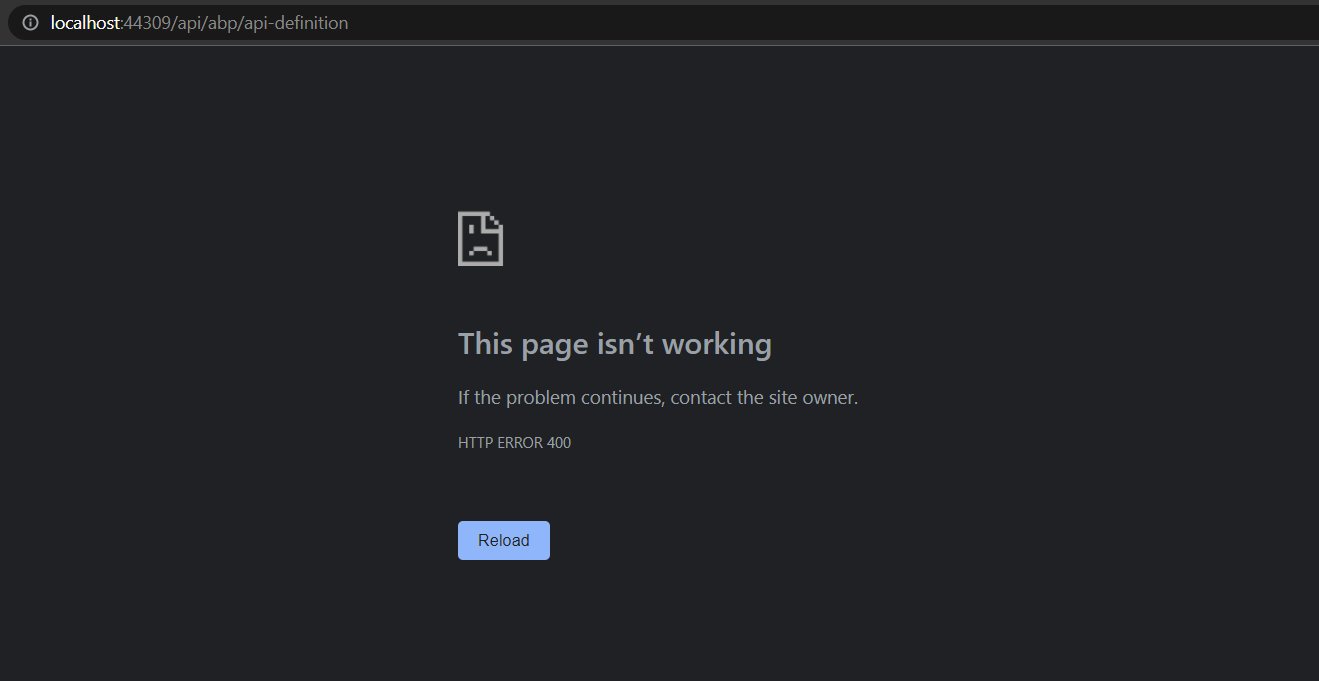Activities of "Anjaneyulu"
Still is there anyway we can encrypt ?
I got an interesting case here... I could solve the above issue by writing extension to Identity EF core repository. No change in the calling function from the client application.
public class XSenseEfCoreIdentityUserRepository : EfCoreIdentityUserRepository, IXSenseIdentityUserRepository
{
public XSenseEfCoreIdentityUserRepository(
IDbContextProvider<IIdentityDbContext> dbContextProvider)
: base(dbContextProvider)
{
}
public virtual async Task<IdentityUser> GetIdentityUserDataAsync(Guid userId)
{
var dbContext = await GetDbContextAsync();
var usersData = await dbContext.Set<IdentityUser>().IncludeDetails(true).Where(u => u.Id == userId).FirstOrDefaultAsync();
return usersData;
}
}
Now i have different issue with
idenityUsermanger.UpdateAsync(user)
Below is the stack trace:
An unhandled exception has occurred while executing the request.
System.OperationCanceledException: The operation was canceled.
at System.Threading.CancellationToken.ThrowOperationCanceledException()
at System.Threading.CancellationToken.ThrowIfCancellationRequested()
at Volo.Abp.Identity.IdentityUserStore.GetSecurityStampAsync(IdentityUser user, CancellationToken cancellationToken)
at Microsoft.AspNetCore.Identity.UserManager`1.GetSecurityStampAsync(TUser user)
at Castle.DynamicProxy.AsyncInterceptorBase.ProceedAsynchronous[TResult](IInvocation invocation, IInvocationProceedInfo proceedInfo)
at Volo.Abp.Castle.DynamicProxy.CastleAbpMethodInvocationAdapterWithReturnValue`1.ProceedAsync()
at Volo.Abp.Uow.UnitOfWorkInterceptor.InterceptAsync(IAbpMethodInvocation invocation)
at Volo.Abp.Castle.DynamicProxy.CastleAsyncAbpInterceptorAdapter`1.InterceptAsync[TResult](IInvocation invocation, IInvocationProceedInfo proceedInfo, Func`3 proceed)
at Microsoft.AspNetCore.Identity.UserManager`1.ValidateUserAsync(TUser user)
at Microsoft.AspNetCore.Identity.UserManager`1.UpdateUserAsync(TUser user)
at Castle.DynamicProxy.AsyncInterceptorBase.ProceedAsynchronous[TResult](IInvocation invocation, IInvocationProceedInfo proceedInfo)
at Volo.Abp.Castle.DynamicProxy.CastleAbpMethodInvocationAdapterWithReturnValue`1.ProceedAsync()
at Volo.Abp.Uow.UnitOfWorkInterceptor.InterceptAsync(IAbpMethodInvocation invocation)
at Volo.Abp.Castle.DynamicProxy.CastleAsyncAbpInterceptorAdapter`1.InterceptAsync[TResult](IInvocation invocation, IInvocationProceedInfo proceedInfo, Func`3 proceed)
at Castle.DynamicProxy.AsyncInterceptorBase.ProceedAsynchronous[TResult](IInvocation invocation, IInvocationProceedInfo proceedInfo)
at Volo.Abp.Castle.DynamicProxy.CastleAbpMethodInvocationAdapterWithReturnValue`1.ProceedAsync()
at Volo.Abp.Uow.UnitOfWorkInterceptor.InterceptAsync(IAbpMethodInvocation invocation)
at Volo.Abp.Castle.DynamicProxy.CastleAsyncAbpInterceptorAdapter`1.InterceptAsync[TResult](IInvocation invocation, IInvocationProceedInfo proceedInfo, Func`3 proceed)
at XSense.Controllers.ComputerController.GetAuthenticationCode(SendAuthenticationRequest request) in D:\Git_Sandbox\XSenseOne\src\XSense.HttpApi\Controllers\ComputerController.cs:line 1207
at Microsoft.AspNetCore.Mvc.Infrastructure.ActionMethodExecutor.TaskOfIActionResultExecutor.Execute(ActionContext actionContext, IActionResultTypeMapper mapper, ObjectMethodExecutor executor, Object controller, Object[] arguments)
at Microsoft.AspNetCore.Mvc.Infrastructure.ControllerActionInvoker.<InvokeActionMethodAsync>g__Awaited|12_0(ControllerActionInvoker invoker, ValueTask`1 actionResultValueTask)
at Microsoft.AspNetCore.Mvc.Infrastructure.ControllerActionInvoker.<InvokeNextActionFilterAsync>g__Awaited|10_0(ControllerActionInvoker invoker, Task lastTask, State next, Scope scope, Object state, Boolean isCompleted)
at Microsoft.AspNetCore.Mvc.Infrastructure.ControllerActionInvoker.Rethrow(ActionExecutedContextSealed context)
at Microsoft.AspNetCore.Mvc.Infrastructure.ControllerActionInvoker.Next(State& next, Scope& scope, Object& state, Boolean& isCompleted)
at Microsoft.AspNetCore.Mvc.Infrastructure.ControllerActionInvoker.<InvokeInnerFilterAsync>g__Awaited|13_0(ControllerActionInvoker invoker, Task lastTask, State next, Scope scope, Object state, Boolean isCompleted)
at Microsoft.AspNetCore.Mvc.Infrastructure.ResourceInvoker.<InvokeNextExceptionFilterAsync>g__Awaited|26_0(ResourceInvoker invoker, Task lastTask, State next, Scope scope, Object state, Boolean isCompleted)
at Microsoft.AspNetCore.Mvc.Infrastructure.ResourceInvoker.Rethrow(ExceptionContextSealed context)
at Microsoft.AspNetCore.Mvc.Infrastructure.ResourceInvoker.Next(State& next, Scope& scope, Object& state, Boolean& isCompleted)
at Microsoft.AspNetCore.Mvc.Infrastructure.ResourceInvoker.<InvokeNextResourceFilter>g__Awaited|25_0(ResourceInvoker invoker, Task lastTask, State next, Scope scope, Object state, Boolean isCompleted)
at Microsoft.AspNetCore.Mvc.Infrastructure.ResourceInvoker.Rethrow(ResourceExecutedContextSealed context)
at Microsoft.AspNetCore.Mvc.Infrastructure.ResourceInvoker.Next(State& next, Scope& scope, Object& state, Boolean& isCompleted)
at Microsoft.AspNetCore.Mvc.Infrastructure.ResourceInvoker.<InvokeFilterPipelineAsync>g__Awaited|20_0(ResourceInvoker invoker, Task lastTask, State next, Scope scope, Object state, Boolean isCompleted)
at Microsoft.AspNetCore.Mvc.Infrastructure.ResourceInvoker.<InvokeAsync>g__Logged|17_1(ResourceInvoker invoker)
at Microsoft.AspNetCore.Mvc.Infrastructure.ResourceInvoker.<InvokeAsync>g__Logged|17_1(ResourceInvoker invoker)
at Microsoft.AspNetCore.Routing.EndpointMiddleware.<Invoke>g__AwaitRequestTask|6_0(Endpoint endpoint, Task requestTask, ILogger logger)
at Swashbuckle.AspNetCore.SwaggerUI.SwaggerUIMiddleware.Invoke(HttpContext httpContext)
at Swashbuckle.AspNetCore.Swagger.SwaggerMiddleware.Invoke(HttpContext httpContext, ISwaggerProvider swaggerProvider)
at Microsoft.AspNetCore.Authorization.AuthorizationMiddleware.Invoke(HttpContext context)
at Cotur.Abp.ApiKeyAuthorization.Http.ApiKeys.ApiKeyAuthorizationMiddleware.InvokeAsync(HttpContext context, RequestDelegate next) in D:\Git_Sandbox\XSenseOne\modules\abp-api-key-authorization\src\Cotur.Abp.ApiKeyAuthorization.AspNetCore\ApiKeys\ApiKeyAuthorizationMiddleware.cs:line 50
at Microsoft.AspNetCore.Builder.UseMiddlewareExtensions.<>c__DisplayClass6_1.<<UseMiddlewareInterface>b__1>d.MoveNext()
--- End of stack trace from previous location ---
at Microsoft.AspNetCore.Builder.ApplicationBuilderAbpOpenIddictMiddlewareExtension.<>c__DisplayClass0_0.<<UseAbpOpenIddictValidation>b__0>d.MoveNext() in D:\Git_Sandbox\XSenseOne\modules\Volo.OpenIddict.Pro\src\Volo.Abp.OpenIddict.AspNetCore\Microsoft\AspNetCore\Builder\ApplicationBuilderAbpOpenIddictMiddlewareExtension.cs:line 21
--- End of stack trace from previous location ---
at Volo.Abp.AspNetCore.Uow.AbpUnitOfWorkMiddleware.InvokeAsync(HttpContext context, RequestDelegate next)
at Microsoft.AspNetCore.Builder.UseMiddlewareExtensions.<>c__DisplayClass6_1.<<UseMiddlewareInterface>b__1>d.MoveNext()
--- End of stack trace from previous location ---
at Volo.Abp.AspNetCore.ExceptionHandling.AbpExceptionHandlingMiddleware.InvokeAsync(HttpContext context, RequestDelegate next)
at Volo.Abp.AspNetCore.ExceptionHandling.AbpExceptionHandlingMiddleware.InvokeAsync(HttpContext context, RequestDelegate next)
at Microsoft.AspNetCore.Builder.UseMiddlewareExtensions.<>c__DisplayClass6_1.<<UseMiddlewareInterface>b__1>d.MoveNext()
--- End of stack trace from previous location ---
at Microsoft.AspNetCore.Authentication.AuthenticationMiddleware.Invoke(HttpContext context)
at XSense.Web.XSenseWebModule.<>c.<<OnApplicationInitialization>b__18_1>d.MoveNext() in D:\Git_Sandbox\XSenseOne\src\XSense.Web\XSenseWebModule.cs:line 562
--- End of stack trace from previous location ---
at Microsoft.AspNetCore.Session.SessionMiddleware.Invoke(HttpContext context)
at Microsoft.AspNetCore.Session.SessionMiddleware.Invoke(HttpContext context)
at Volo.Abp.AspNetCore.Tracing.AbpCorrelationIdMiddleware.InvokeAsync(HttpContext context, RequestDelegate next)
at Microsoft.AspNetCore.Builder.UseMiddlewareExtensions.<>c__DisplayClass6_1.<<UseMiddlewareInterface>b__1>d.MoveNext()
--- End of stack trace from previous location ---
at Microsoft.AspNetCore.Localization.RequestLocalizationMiddleware.Invoke(HttpContext context)
at Microsoft.AspNetCore.RequestLocalization.AbpRequestLocalizationMiddleware.InvokeAsync(HttpContext context, RequestDelegate next)
at Microsoft.AspNetCore.Builder.UseMiddlewareExtensions.<>c__DisplayClass6_1.<<UseMiddlewareInterface>b__1>d.MoveNext()
--- End of stack trace from previous location ---
at Microsoft.AspNetCore.Diagnostics.DeveloperExceptionPageMiddlewareImpl.Invoke(HttpContext context)
All the apis are working good earlier, but recently we have to flush the data and after that it seems we are having this issues. I couldnt guess what went wrong.
Hi,
Calling in golang application:
API : APIGetUser string = "/api/pc/get-user-info"
Libhandle is structure to handle the api & db configuration , Where is client is an http client implementationf for api calls.
type LibHandle struct {
db *adapter.Adapter
log logger.Logger
cfg *Config
c *Client
}
Calling Function :
func (h *LibHandle) getUser(userName string, localUser bool) (*UserCrdential, bool, error) {
uc, noLocalUser := h.getLocalUser(userName)
mr := make(map[string]interface{})
mr["UID"] = h.getUID()
mr["UserName"] = userName
``` req, err := h.getRequest("POST", APIGetUser, mr) ```
if err != nil {
h.log.Error("Failed to get user, failed to create API request", "err", err)
if noLocalUser {
return nil, false, err
}
return uc, true, nil
}
// q := req.URL.Query()
// q.Add("UID", h.getUID())
// q.Add("UserName", userName)
// req.URL.RawQuery = q.Encode()
```resp, err := h.c.Do(req) ```
if err != nil {
h.log.Error("Failed to get user, invalid response from the server", "err", err)
if noLocalUser {
return nil, false, err
}
return uc, true, nil
}
defer resp.Body.Close()
if resp.StatusCode != http.StatusOK {
h.log.Error("Failed to get user, get user failed with status", "status", resp.StatusCode)
if noLocalUser {
return nil, false, err
}
return uc, true, nil
}
var ud UserDetials
err = jsonutil.DecodeJSONFromReader(resp.Body, &ud)
if err != nil {
h.log.Error("Failed to get user, failed to parse the json", "err", err)
if noLocalUser {
return nil, false, err
}
return uc, true, nil
}
}
Function : Common function to form a request based on the provided method,route and inputs >> h.getRequest("POST", APIGetUser, Mr)
func (h *LibHandle) getRequest(method string, path string, model interface{}) (*http.Request, error) {
req, err := h.c.JSONRequest(method, path, model)
if err != nil {
return nil, err
}
//req.Header.Add("XSENSE-APP-ID", h.cfg.AppID)
req.Header.Add("XSENSE-API-KEY", h.cfg.AppSecret)
return req, nil
}
func (c *Client) JSONRequest(method string, requestPath string, model interface{}) (*http.Request, error) {
var body *bytes.Buffer
if model != nil {
j, err := json.Marshal(model)
if err != nil {
return nil, err
}
body = bytes.NewBuffer(j)
} else {
body = bytes.NewBuffer(make([]byte, 0))
}
url := &url.URL{
Scheme: c.addr.Scheme,
Host: c.addr.Host,
User: c.addr.User,
Path: path.Join(c.addr.Path, requestPath),
}
req, err := http.NewRequest(method, url.RequestURI(), body)
req.Host = url.Host
req.URL.User = url.User
req.URL.Scheme = url.Scheme
req.URL.Host = url.Host
req.Header.Set("Content-Type", "application/json")
return req, err
}
Function : Common function to excute the request >> resp, err := h.c.Do(req)
func (c *Client) Do(req *http.Request, timeout ...time.Duration) (*http.Response, error) {
if timeout != nil {
c.hc.Timeout = timeout[0]
} else {
c.hc.Timeout = c.defaultTimeout
}
return c.hc.Do(req)
}
Hope this helps .
If i have to give the updated files after install libs, what are the minimum file i need to share from the publish folder to client.
Thank you for prompt response . Will check and update you.
Steps:
- Run the demo server and login into application as host.
- Create a tenant
- Login into tenant page and add any openid client in the Openid applications
- You can also check our sample ebanking in the test folder in repository
- After adding an openid client in server, configure the client with the client,secret and default scopes.
- Try logging in to the openid client application.
- Try logout.
- It is not logging out. If you open the url again it is navigating to the main page with out asking login credentials.
HI @maliming, we have created a basic abp project. @ https://github.com/rajasekhard2015/demo
Tried extending openid dict to tenant . Please check the commits to see what all changes we have made.
We were able to add client and do authentication. but we are having issue for logout.
Can you please help us. It very critical for our delivery.
Configure<AbpAntiForgeryOptions>(options => { options.AutoValidateIgnoredHttpMethods.Remove("GET"); //auto validate for GET requests });After I've configured the
AbpAntiForgeryOptionsas above, I could not send a successful GET request to my endpoints unless I provide aRequestVerificationTokenheader.But if there is an interceptor and passes a
RequestVerificationTokenon behalf of me, I can successfully make a GET request as follow. (And we do it on Swagger UI)
So can you try to navigate the URL of one of your GET requests on the browser? I am not sure but "burpsuite" might be intercepting the request and passing the
RequestVerificationTokenautomatically (maybe you can check the header that it passed).
After adding this configuration we are not getting data for our Get request : -
Configure<AbpAntiForgeryOptions>(options => { options.AutoValidateIgnoredHttpMethods.Remove("GET"); //auto validate for GET requests });
But Adding this middleware , we are getting data but intercepting through burpsuite , removing request verification token and forwarding request is working fine.
public class SetRequestVerificationHeaderMiddleware { private readonly RequestDelegate _next; private readonly IAbpAntiForgeryManager _abpAntiForgeryManager;
public ValidateAntiForgeryTokenMiddleware(RequestDelegate next, IAbpAntiForgeryManager abpAntiForgeryManager)
{
_next = next;
_abpAntiForgeryManager = abpAntiForgeryManager;
}
public async Task Invoke(HttpContext context)
{
if (HttpMethods.IsGet(context.Request.Method))
{
var antiForgeryToken = await _abpAntiForgeryManager.GenerateToken();
context.Request.Headers["RequestVerificationToken"] = antiForgeryToken;
}
await _next(context);
}
}
//use middleware app.UseMiddleware<SetRequestVerificationHeaderMiddleware>();
Even Im not sure how burpsuite works.
Configure<AbpAntiForgeryOptions>(options => { options.AutoValidateIgnoredHttpMethods.Remove("GET"); //auto validate for GET requests });After I've configured the
AbpAntiForgeryOptionsas above, I could not send a successful GET request to my endpoints unless I provide aRequestVerificationTokenheader.But if there is an interceptor and passes a
RequestVerificationTokenon behalf of me, I can successfully make a GET request as follow. (And we do it on Swagger UI)
So can you try to navigate the URL of one of your GET requests on the browser? I am not sure but "burpsuite" might be intercepting the request and passing the
RequestVerificationTokenautomatically (maybe you can check the header that it passed).
Thanks. I will check and Let you know
Hi @Anjaneyulu, you're not sending requests via Swagger right?
No. Actually we are intercepting the get request in burpsuite , removing the request verification token and forwarding the request to server. Should we consider burpsuite interpection as a swagger or postman request? I'm not sure.

